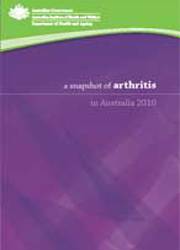Summary
- Arthritis is one of the most common long-term diseases in Australia. More than 3.1 million Australians (15.2% of the total population) were estimated to be affected by arthritis in 2007–08. The disease is more common in females than in males.
- The prevalence of arthritis increased from 13.6% to 15.3% between 2001 and 2004–05. However, almost no change in its prevalence was noted between 2004–05 and 2007–08.
- Indigenous Australians have higher prevalence of arthritis than non-Indigenous Australians. Socioeconomic factors also influence the prevalence of arthritis in Australia.
- Arthritis is a significant contributor to disability in Australia; almost one-third of people with the disease report some core activity restrictions. However, only one out of seven people have severe or profound activity restrictions.
- It is the eighth most frequently managed problem by general practitioners (GPs) in Australia. In GP–patient encounters, it was managed at the rate of 3.6 per 100 encounters in 2007–08.
- There are more than 100 types of arthritis. Osteoarthritis and rheumatoid arthritis are two of its most common types. Osteoarthritis affects an estimated 1.6 million Australians, and over 428,000 people are estimated to have rheumatoid arthritis.
- The prevalence of osteoarthritis has fluctuated around 7.5% to 7.6% since 2001. The prevalence of rheumatoid arthritis however, declined from 2.4% to 2.1% between 2001 and 2007–08.
- Osteoarthritis is the major underlying factor in the need for joint replacements, in particular those of the knee or hip. More than 97% of knee and hip replacements attributed to arthritis are on account of osteoarthritis.
- Both knee and hip replacements due to arthritis are on the increase. Between 2000–01 and 2007–08, the number of total knee replacements increased from 16,089 to 26,712, an increase of 67% over 7 years. Total hip replacements during the same period increased by 40%, from 14,416 to 19,279.
- Arthritis and musculoskeletal conditions are a major cause of health expenditure. In 2004–05, they accounted for $4.0 billion in direct expenditure. Osteoarthritis and rheumatoid arthritis were responsible for about one-third of this expenditure.



